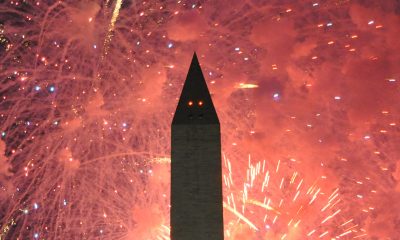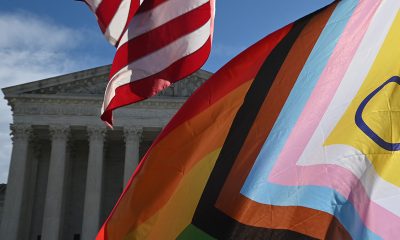Books
Washington Blade editor tells all in new book
Kevin Naff revisits 20 years in the battle for LGBTQ equality in tome that is part history lesson, part celebrity dish
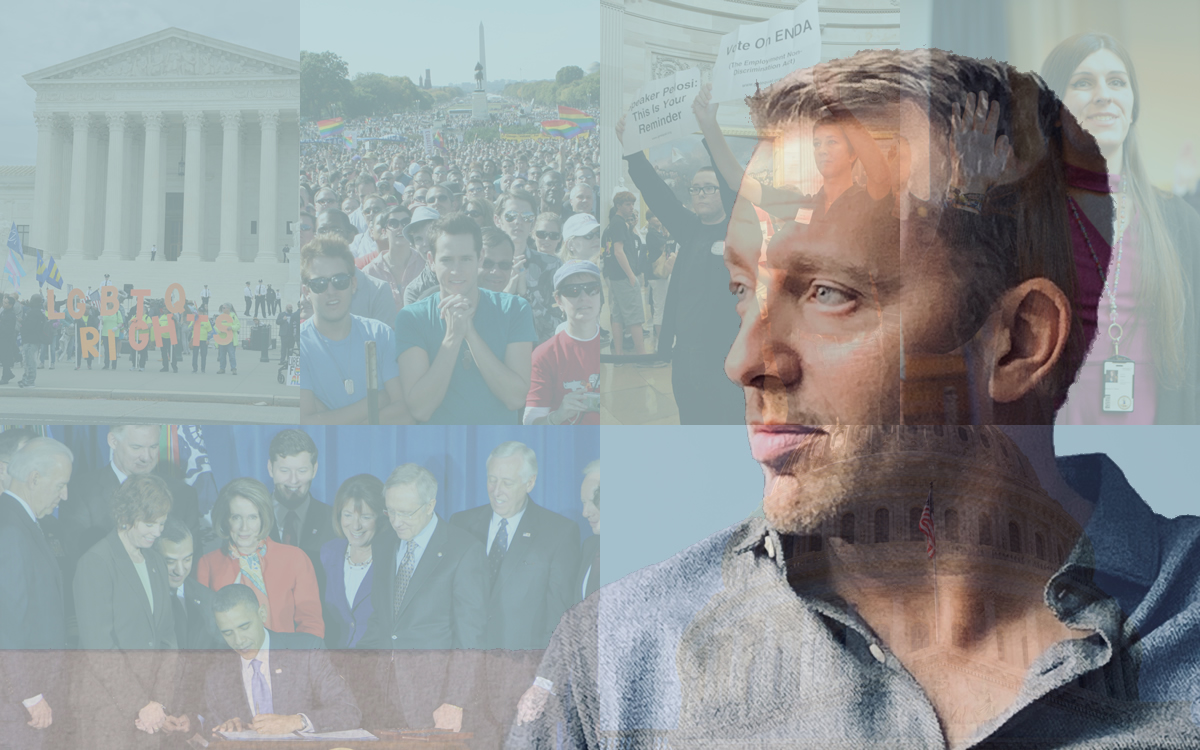
Washington Blade Editor Kevin Naff this week published his first book, “How We Won the War for LGBTQ Equality — And How Our Enemies Could Take It All Away.”
The book commemorates Naff’s 20 years editing the Blade and features two decades of his work updated with new insights and commentary, touching on everything from the fight for marriage equality and repeal of “Don’t Ask, Don’t Tell” to celebrity encounters and the outing of public figures.
It’s part history lesson and part celebrity dish, available now at Amazon.com and kevinnaff.com.
The following is adapted from an interview between Rob Watson of Rated LGBT Radio and Naff. To listen to the full interview, visit blogtalkradio.com/ratedlgbtradio.
The two-decades long war in Afghanistan was the longest in U.S. history. Wars for civil rights have been much longer, and for many, nowhere near over. Ours for LGBTQ rights is a prime example.
While gains in our particular war have been many, and by historical standards, have come incredibly fast, they have now been fought by several generations.
Author and Washington Blade editor Kevin Naff highlights this perspective in his new book “How We Won the War for LGBTQ Equality.”
“Two decades represents a mere blip in the arc of a civil rights struggle, yet in that span, the LGBTQ community in the United States went from legally second-class status to enjoying near full protection of federal law along with widespread societal acceptance and even full marriage rights,” Naff writes.
He is aware that this look into our collective history represents a glimpse into a broader, and more painful fight, where many LGBTQ families lost their fights. “Not a week has gone by in my 20 years at the Blade that I didn’t think of the generation of gay men before me who didn’t live to see all of this progress,” he writes. “They inspire me. I do this work for them. They did not die in vain. Not just the men who died, but the lesbians who cared for them when no one else would. They are not forgotten.”
“This is not a dry history lesson type of book, but if you want to learn, the book does tell the marriage equality battle, ‘Don’t Ask Don’t Tell,’ and how a lot of our wins unfolded,” Naff declared when he sat down with me on the Rated LGBT Radio podcast.
He’s right. “How to Win” shares many of Naff’s articles written as events were unfolding. Absorbing these as a modern reader, I found my deep desire to fight against anything less than full equality, and repression against our abilities to self-actualize, getting hungrier and hungrier.
For those wanting “shade and the truth,” this book delivers, as it’s filled with page-turning anecdotes to keep you glued and voracious right to the very end.
Like many of us, Naff was persecuted for being perceived as gay when he was a kid. “The walk home from school was particularly terrifying — I walked alone and my tormentors would often follow, hurling rocks and anti-gay slurs. Sometimes the fear was so intense that I would feign sick just to avoid a day of the torture,” he writes. His youth was not a time when there was much sympathy, or help, for LGBTQ children. It was the time of do-it-yourself. “There was the day I finally snapped, in seventh grade, while being taunted by a kid in gym class. The insults and threats became too much and all the anger rushed out of me…I defended myself. And it felt good,” Naff reveals. He acknowledges that his bullies “forced me to cultivate an inner strength.”
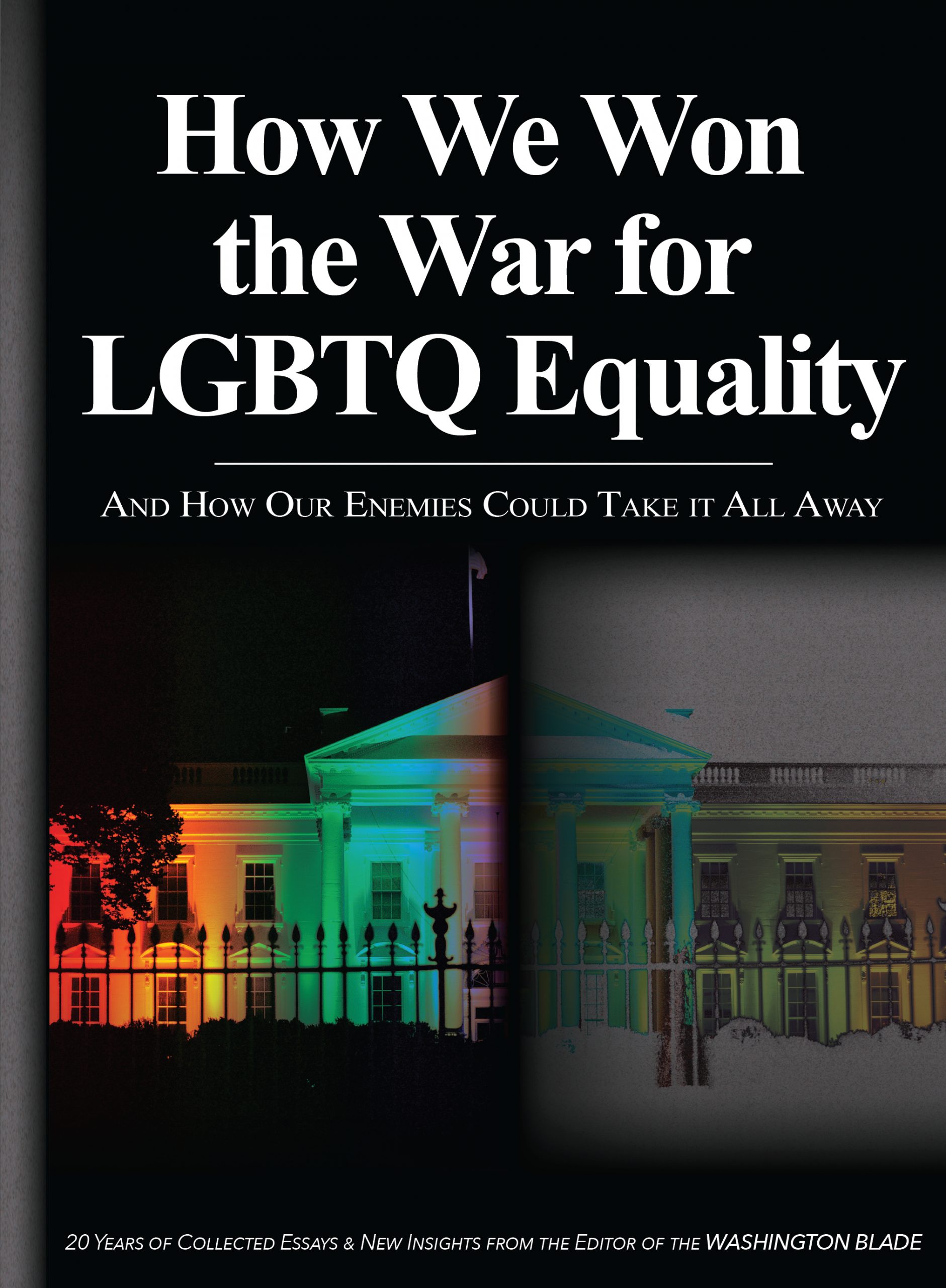
Years later, as a journalist and conscience for public progressives, Naff’s unwillingness to back down, and passion to stand and fight, emerge time and time again in the book.
While he writes of contempt for George W. Bush’s opportunistic use of same-sex marriage as a campaign wedge issue, Naff stepped up his fight to the next level when facing Maryland Gov. Martin O’Malley. O’Malley was a progressive who used LGBTQ goodwill and campaign muscle to get elected. When an appeals court rejected same-sex marriage, O’Malley went from champion to cad at light speed. He issued an offensive statement about Catholic sacraments and asserted his opposition to marriage equality.
So, Naff outed the governor’s brother, Patrick. (That the brother was gay was a fact commonly known in social circles, but had not reached the media level previously).
The governor was mad, but Naff landed a one-on-one interview with O’Malley, and eventually a path to the governor flipping support on the issue.
Naff’s unwillingness to allow LGBTQ people to be pushed around is not just with public figures who use us and then abandon us, people he calls “duplicitous allies,” but he feels no hesitancy in confronting Hollywood icons and their cults, as John Travolta found out.
Naff went viral with a piece in 2007 when he wrote a blog post criticizing the casting of a potentially closeted and indoctrinated Scientologist John Travolta, as the Divine-inspired drag role in John Waters’ musical version of “Hairspray.”
That post “generated the most attention and traffic of anything I’ve written,” Naff says. “My blog post encouraged gay fans to boycott the new film because its star, John Travolta, was Scientology’s No. 2 spokesperson and his cult was known to engage in reparative therapy, the debunked practice of changing one’s sexual orientation.”
Mainstream gossip media declared that “the gays were boycotting Hairspray.” Soon Naff found himself inundated with death threats, and being summoned by both Fox News and the Church of Scientology itself.
Naff agreed to a face off with Fox’s Bill O’Reilly whose friendly off-air persona turned rabid in front of the cameras. When Naff pointed out that he was comparing gay people to drug addicts, O’Reilly snarled, “Don’t be a wise guy, Mr. Naff.”
Naff’s biggest sin, according to the Church of Scientology, was referring to it as a “cult.” To prove that they weren’t, the president of the D.C. church invited Naff for a meeting. Upon arrival at the Scientology mansion in Dupont Circle, the church president gave Naff a tour, which included an “immaculate first-floor formal office.” After inquiring whose office it was, Naff was told that it was “Mr. Hubbard’s office” and that every church location had one. Scientology founder L. Ron Hubbard had been dead for 21 years at that point.
“Cult!” Naff and I exclaimed in unison as he told me the story.
As editor of the Washington Blade, Naff is an established invitee to the journalistic event of each season: The White House Correspondents’ Association Dinner. He writes about his dates he has taken each year from the heavenly (Judith Light) to the disastrous (Kathy Griffin). The latter made a point to scream expletives at Trump administration officials in attendance.
While Naff could appreciate the sentiment, Griffin left D.C. the next day, while he, the in-town professional, had to face all of her targets.
Laverne Cox was also a standout date. She accompanied Naff the night after Caitlyn Jenner’s televised coming out interview aired. “If one more reporter asks me about fucking Caitlyn Jenner, I’m going to lose it,” Naff reports Cox confiding. His story about Laverne Cox was not so much about Jenner, however, but reads like something out of “Oceans 8.”
Unlike the movie, Naff’s evening did not feature a planned jewel heist, nor were Sandra Bullock and Cate Blanchett anywhere in sight, but it did feature a pricey borrowed diamond bracelet that went missing off of Cox’s wrist. She feared the jeweler would accuse her of theft. The dilemma ultimately had one of the most famous transgender actresses of all time, and the editor of the nation’s oldest LGBTQ publication frantically crawling under banquet tables surrounded by the Washington elite and press corps.
Cox finally found the bauble at 4 a.m., deep at the bottom of her purse.
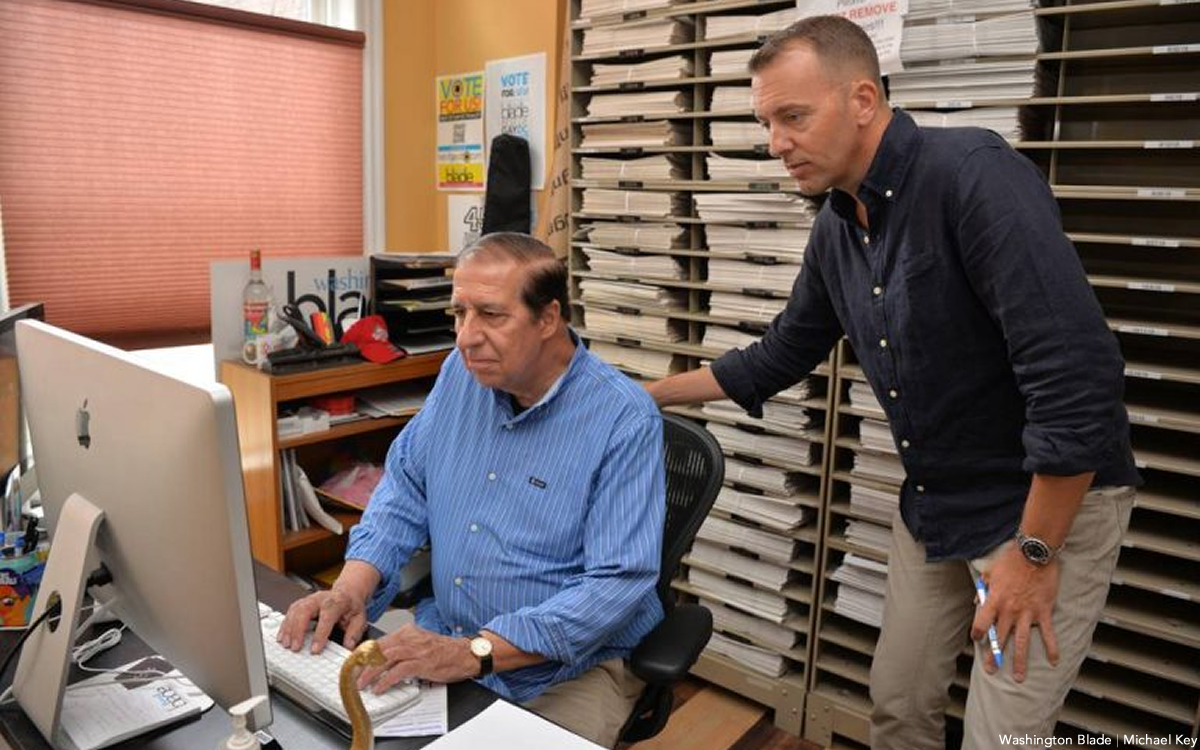
“How We Won” covers the arc of LGBTQ history over two crucial decades and hits on topics from bullying of youth, the “ex-gay” movement, the military, religion, police, and, of course, marriage equality. Besides his adventures with cults chasing him down, A-lister dates and angry governors, Naff also shares poignant emotional moments of his own.
One came in shocking fashion when he arrived to the Washington Blade offices one morning to find two men from the Blade’s then-parent company. They were there to shut the place down after a Chapter 7 bankruptcy filing.
Naff retreated to his office, scrambling to think out the next move. The Blade staff resolved to not give up and successfully put out a slim newssheet for a few months until they could recover the Blade’s assets from the bankruptcy court and keep the legacy alive.
One of the great ironies of the LGBTQ movement is that many people who have fought for progress are not the ones who live to enjoy all the gains. They win the battles but leave the new world for others to fully enjoy.
Naff is one of those pioneers. After an adult life fighting for LGBTQ people to exercise the right to marry our loves in a fully public, accepting way, challenging all who might deny a same-sex couple service, Naff had a life-changing revelation that made him choose to walk away from a huge wedding event for himself.
Months before his own wedding, he was in a serious automobile accident. He called his fiancé and pitched the idea of a small ceremony on the beach, followed by a gay cruise together around Asia. “Something happens when you are faced with a life-or-death kind of moment. It changes what’s important. It changes your perspective,” he tells me.
Naff started out his writing career as a 10-year-old writing to the Washington Post as a pissed-off Baltimore Orioles fan protesting the Major League Baseball strike of 1981. “I am STILL a pissed off Baltimore Orioles fan,” he says. From day one, he found his knack for observation and his gift for pointed communication. Those are the same qualities he brings to his participation in, and presentation of, our LGBTQ historic trek to equality victory.
In “How We Won,” he tells an unvarnished story, as he saw it, as he wrote about it, and continues to tell it, at the helm of the Washington Blade. He tells of the right-wing figures he confronted and continues to confront. He thinks of the term “outing” as an archaic term. Today, it is simply “truth-telling” of those in the public eye. As much as the title of his book implies a “win” and completion, I am confident that the 10-year-old pissed-off Baltimore Orioles fan within is not done.
Naff’s subtitle, after all, is “And How Our Enemies Could Take it All Away.”
A post-war recap for Kevin Naff might have been best expressed by the fictional Mr. Incredible when he said, “No matter how many times you save the world, it always manages to get back in jeopardy again. Sometimes I just want it to stay saved!”
As homophobic, transphobic Republican legislation sweeps the country, it is clear, we are not done and a new chapter in the war has begun. At the end of “The Incredibles,” continuing the allegory, after a family of progressives have saved the world, a huge noisy crew disrupts it (symbolic of the MAGA wave). Out pops the Under-Miner who declares, “Behold, The Under-Miner! I am always beneath you, but NOTHING is beneath me! (As it seems so for the GOP.) I hereby declare war on peace and happiness! Soon all will tremble before me!”
The music swells, and the family of authentic-selves look at each other with a smirk, opening their shirts to reveal that they are Incredibles. They know that this time, like last time, they will not be defeated.
So stands Kevin Naff, looking back and looking forward, with his band of Incredibles, LGBTQ journalists worldwide, and the rest of us, ready to fight the fight again.
As we prepare for the new battles ahead, the principles of “How We Won” will be our tools for ultimate victory: be visible, be assertive, confront lies and injustice, reinvent, rebirth and in the end, hold our personal loves sacred.
Kevin Naff and Mr. Incredible would stand for nothing less. Neither should you.
Books
Two new books on dining out LGBTQ-style
Visit nightclubs, hamburger joints, and a bathhouse that feeds customers

‘What is Queer Food? How We Served a Revolution’
By John Birdsall
c.2025, W.W. Norton
$29.99/304 pages
‘Dining Out: First Dates, Defiant Nights, and Last Call Disco Fries at America’s Gay Restaurants’
By Erik Piepenburg
c.2025, Grand Central
$30/352 pages
You thought a long time about who sits where.
Compatibility is key for a good dinner party, so place cards were the first consideration; you have at least one left-hander on your guest list, and you figured his comfort into your seating chart. You want the conversation to flow, which is music to your ears. And you did a good job but, as you’ll see with these two great books on dining LGBTQ-style, it’s sometimes not who sits where, but whose recipes were used.
When you first pick up “What is Queer Food?” by John Birdsall, you might miss the subtitle: “How We Served a Revolution.” It’s that second part that’s important.

Starting with a basic gay and lesbian history of America, Birdsall shows how influential and (in)famous 20th century queer folk set aside the cruelty and discrimination they received, in order to live their lives. They couldn’t speak about those things, he says, but they “sat down together” and they ate.
That suggested “a queer common purpose,” says Birdsall. “This is how who we are, dahling, This is how we feed our own. This is how we stay alive.”
Readers who love to cook, bake or entertain, collect cookbooks, or use a fork will want this book. Its stories are nicely served, they’re addicting, and they may send you in search of cookbooks you didn’t know existed.
Sometimes, though, you don’t want to be stuck in the kitchen, you want someone else to bring the grub. “Dining Out” by Erik Piepenburg is an often-nostalgic, lively look at LGBTQ-friendly places to grab a meal – both now and in the past.

In his introduction, Piepenburg admits that he’s a journalist, “not a historian or an academic,” which colors this book, but not negatively. Indeed, his journeys to “gay restaurants” – even his generous and wide-ranging definitions of the term – happily influence how he presents his narrative about eateries and other establishments that have fed protesters, nourished budding romances, and offered audacious inclusion.
Here, there are modern tales of drag lunches and lesbian-friendly automats that offered “cheap food” nearly a century ago. You’ll visit nightclubs, hamburger joints, and a bathhouse that feeds customers on holidays. Stepping back, you’ll read about AIDS activism at gay-friendly establishments, and mostly gay neighborhood watering holes. Go underground at a basement bar; keep tripping and meet proprietors, managers, customers and performers. Then take a peek into the future, as Piepenburg sees it.
The locales profiled in “Dining Out” may surprise you because of where they can be found; some of the hot-spots practically beg for a road trip.
After reading this book, you’ll feel welcome at any of them.
If these books don’t shed enough light on queer food, then head to your favorite bookstore or library and ask for help finding more. The booksellers and librarians there will put cookbooks and history books directly in your hands, and they’ll help you find more on the history and culture of the food you eat. Grab them and you’ll agree, they’re pretty tasty reads.
The Blade may receive commissions from qualifying purchases made via this post.

You’re going to be on your feet a lot this month.
Marching in parades, dancing in the streets, standing up for people in your community. But you’re also likely to have some time to rest and reflect – and with these great new books, to read.
First, dip into a biography with “Marsha: The Joy and Defiance of Marsha P. Johnson” by Tourmaline (Tiny Rep Books, $30), a nice look at an icon who, rumor has it, threw the brick that started a revolution. It’s a lively tale about Marsha P. Johnson, her life, her activism before Stonewall and afterward. Reading this interesting and highly researched history is a great way to spend some time during Pride month.
For the reader who can’t live without music, try “The Dad Rock That Made Me a Woman” by Niko Stratis (University of Texas Press, $27.95), the story of being trans, searching for your place in the world, and finding it in a certain comfortable genre of music. Also look for “The Lonely Veteran’s Guide to Companionship” by Bronson Lemer (University of Wisconsin Press, $19.95), a collection of essays that make up a memoir of this and that, of being queer, basic training, teaching overseas, influential books, and life.
If you still have room for one more memoir, try “Walk Like a Girl” by Prabal Gurung (Viking, $32.00). It’s the story of one queer boy’s childhood in India and Nepal, and the intolerance he experienced as a child, which caused him to dream of New York and the life he imagined there. As you can imagine, dreams and reality collided but nonetheless, Gurung stayed, persevered, and eventually became an award-winning fashion designer, highly sought by fashion icons and lovers of haute couture. This is an inspiring tale that you shouldn’t miss.
No Pride celebration is complete without a history book or two.
In “Trans History: From Ancient Times to the Present Day” by Alex L. Combs & Andrew Eakett ($24.99, Candlewick Press), you’ll see that being trans is something that’s as old as humanity. One nice part about this book: it’s in graphic novel form, so it’s lighter to read but still informative. Lastly, try “So Many Stars: An Oral History of Trans, Nonbinary, Genderqueer, and Two-Spirit People of Color” by Caro De Robertis (Algonquin Books of Chapel Hill. $32.00) a collection of thoughts, observations, and truths from over a dozen people who share their stories. As an “oral history,” you’ll be glad to know that each page is full of mini-segments you can dip into anywhere, read from cover to cover, double-back and read again. It’s that kind of book.
And if these six books aren’t enough, if they don’t quite fit what you crave now, be sure to ask your favorite bookseller or librarian for help. There are literally tens of thousands of books that are perfect for Pride month and beyond. They’ll be able to determine what you’re looking for, and they’ll put it directly in your hands. So stand up. March. And then sit and read.
a&e features
James Baldwin bio shows how much of his life is revealed in his work
‘A Love Story’ is first major book on acclaimed author’s life in 30 years

‘Baldwin: A Love Story’
By Nicholas Boggs
c.2025, FSG
$35/704 pages
“Baldwin: A Love Story” is a sympathetic biography, the first major one in 30 years, of acclaimed Black gay writer James Baldwin. Drawing on Baldwin’s fiction, essays, and letters, Nicolas Boggs, a white writer who rediscovered and co-edited a new edition of a long-lost Baldwin book, explores Baldwin’s life and work through focusing on his lovers, mentors, and inspirations.
The book begins with a quick look at Baldwin’s childhood in Harlem, and his difficult relationship with his religious, angry stepfather. Baldwin’s experience with Orilla Miller, a white teacher who encouraged the boy’s writing and took him to plays and movies, even against his father’s wishes, helped shape his life and tempered his feelings toward white people. When Baldwin later joined a church and became a child preacher, though, he felt conflicted between academic success and religious demands, even denouncing Miller at one point. In a fascinating late essay, Baldwin also described his teenage sexual relationship with a mobster, who showed him off in public.
Baldwin’s romantic life was complicated, as he preferred men who were not outwardly gay. Indeed, many would marry women and have children while also involved with Baldwin. Still, they would often remain friends and enabled Baldwin’s work. Lucien Happersberger, who met Baldwin while both were living in Paris, sent him to a Swiss village, where he wrote his first novel, “Go Tell It on the Mountain,” as well as an essay, “Stranger in the Village,” about the oddness of being the first Black person many villagers had ever seen. Baldwin met Turkish actor Engin Cezzar in New York at the Actors’ Studio; Baldwin later spent time in Istanbul with Cezzar and his wife, finishing “Another Country” and directing a controversial play about Turkish prisoners that depicted sexuality and gender.
Baldwin collaborated with French artist Yoran Cazac on a children’s book, which later vanished. Boggs writes of his excitement about coming across this book while a student at Yale and how he later interviewed Cazac and his wife while also republishing the book. Baldwin also had many tumultuous sexual relationships with young men whom he tried to mentor and shape, most of which led to drama and despair.
The book carefully examines Baldwin’s development as a writer. “Go Tell It on the Mountain” draws heavily on his early life, giving subtle signs of the main character John’s sexuality, while “Giovanni’s Room” bravely and openly shows a homosexual relationship, highly controversial at the time. “If Beale Street Could Talk” features a woman as its main character and narrator, the first time Baldwin wrote fully through a woman’s perspective. His essays feel deeply personal, even if they do not reveal everything; Lucian is the unnamed visiting friend in one who the police briefly detained along with Baldwin. He found New York too distracting to write, spending his time there with friends and family or on business. He was close friends with modernist painter Beauford Delaney, also gay, who helped Baldwin see that a Black man could thrive as an artist. Delaney would later move to France, staying near Baldwin’s home.
An epilogue has Boggs writing about encountering Baldwin’s work as one of the few white students in a majority-Black school. It helpfully reminds us that Baldwin connects to all who feel different, no matter their race, sexuality, gender, or class. A well-written, easy-flowing biography, with many excerpts from Baldwin’s writing, it shows how much of his life is revealed in his work. Let’s hope it encourages reading the work, either again or for the first time.
-

 U.S. Supreme Court3 days ago
U.S. Supreme Court3 days agoSupreme Court to consider bans on trans athletes in school sports
-

 Out & About3 days ago
Out & About3 days agoCelebrate the Fourth of July the gay way!
-

 Virginia3 days ago
Virginia3 days agoVa. court allows conversion therapy despite law banning it
-

 Maryland5 days ago
Maryland5 days agoLGBTQ suicide prevention hotline option is going away. Here’s where else to go in Md.

